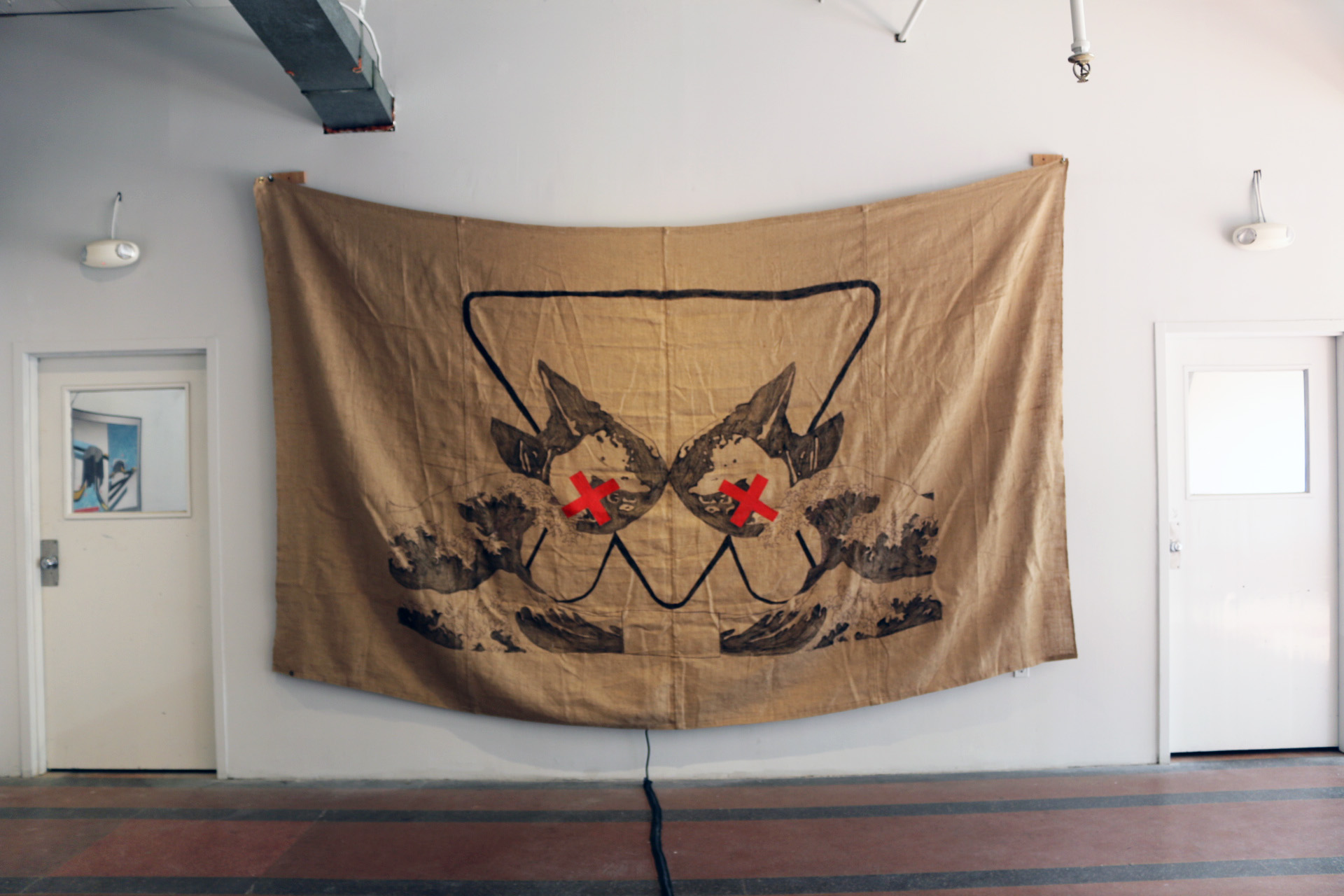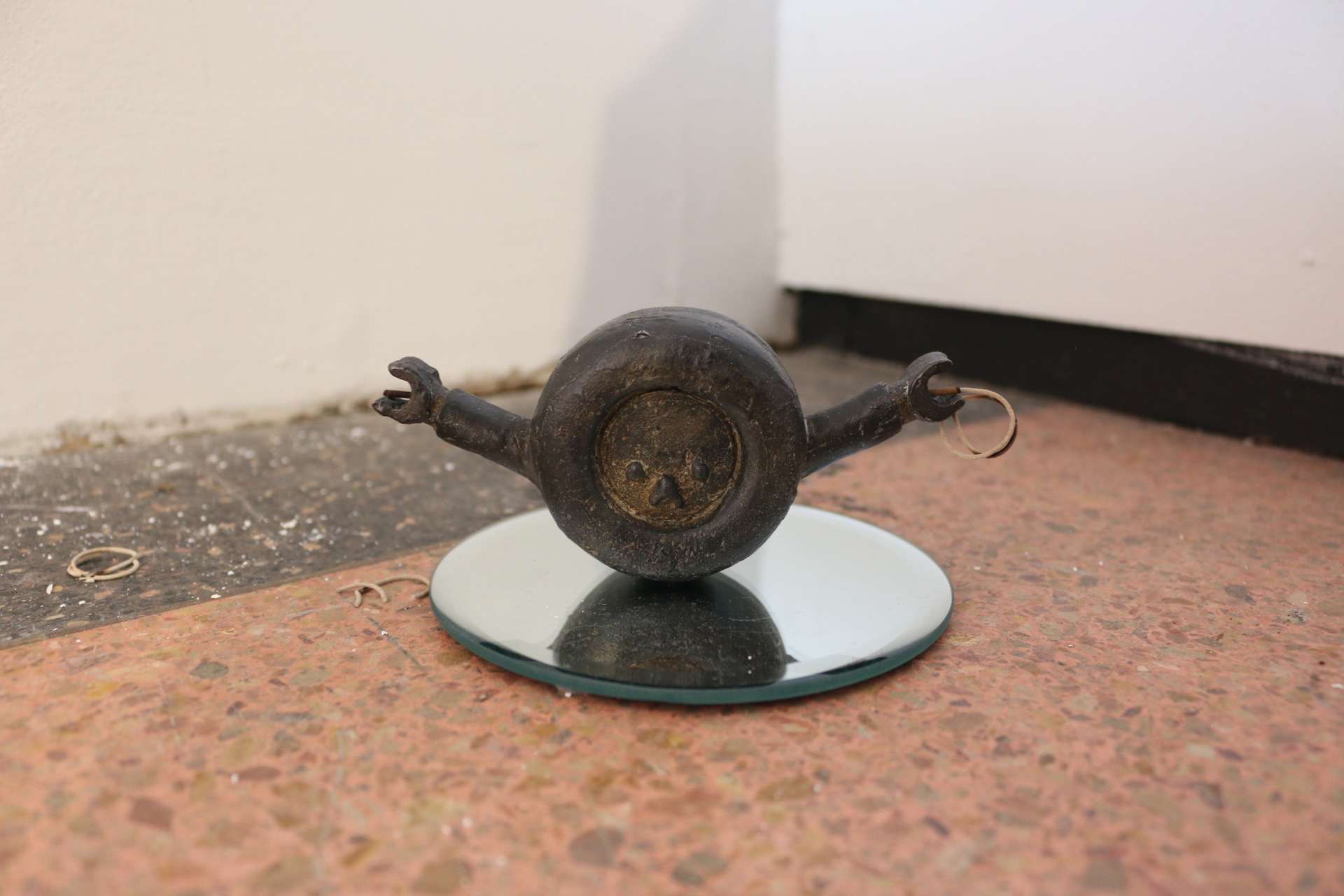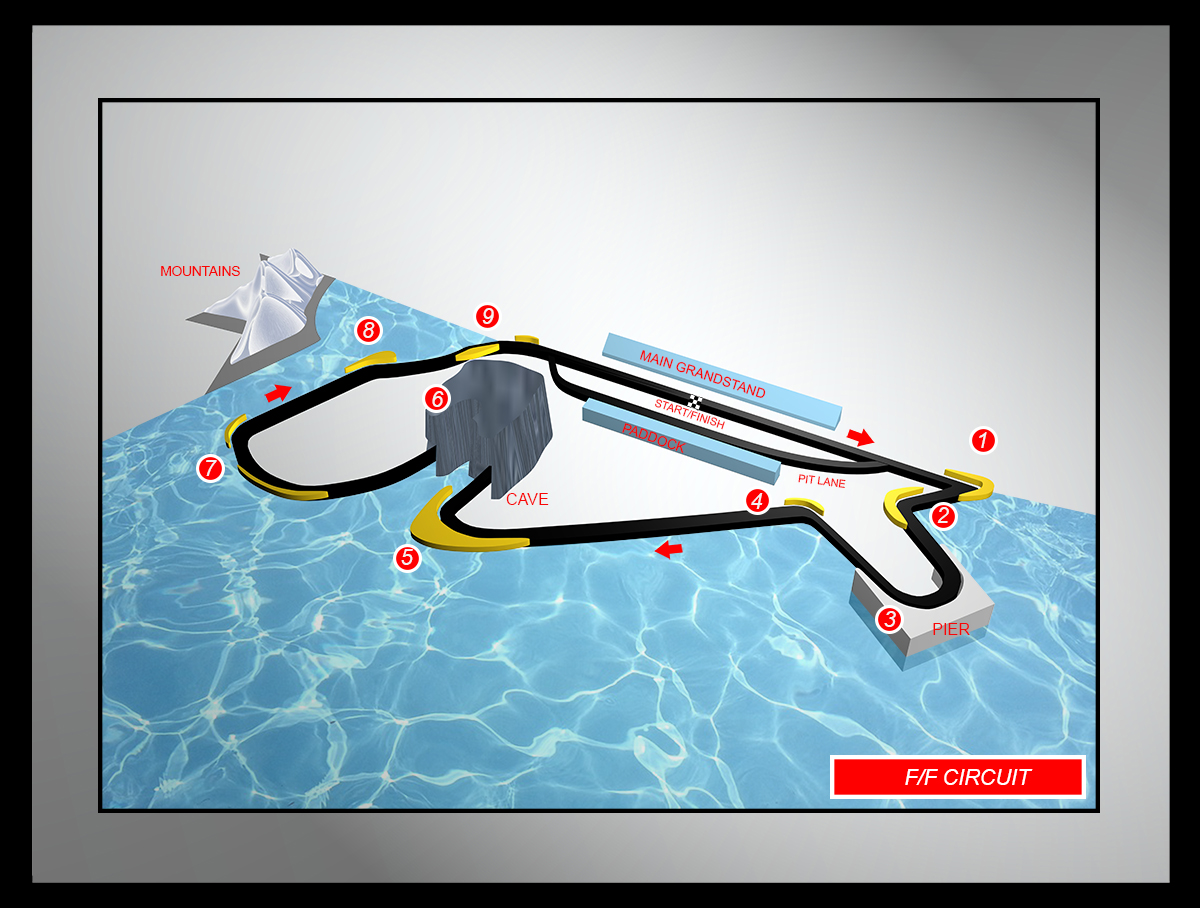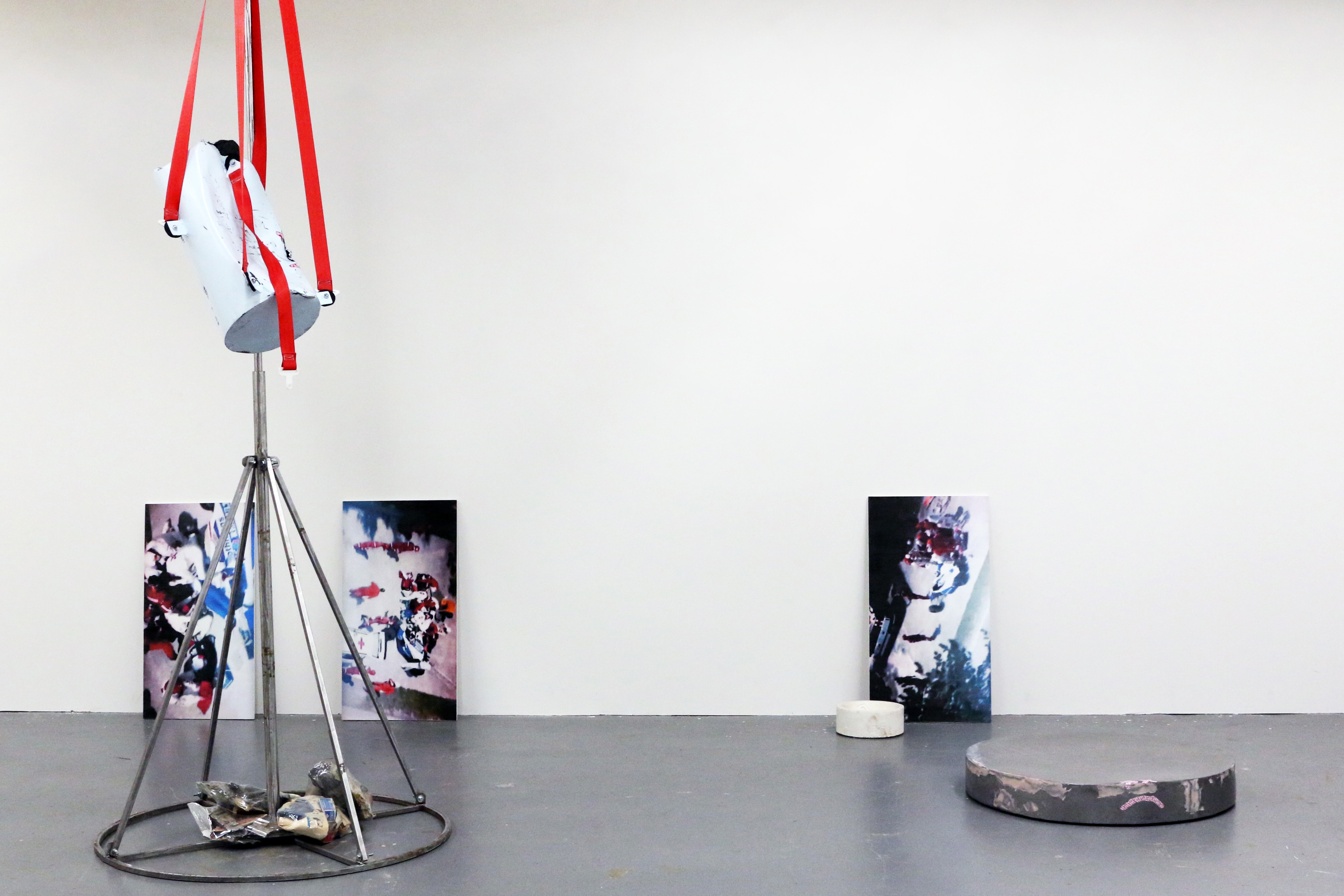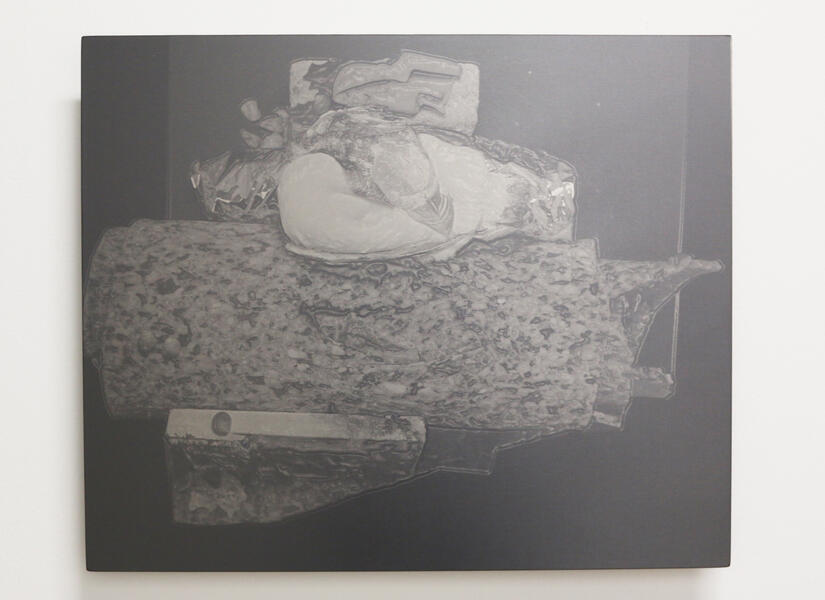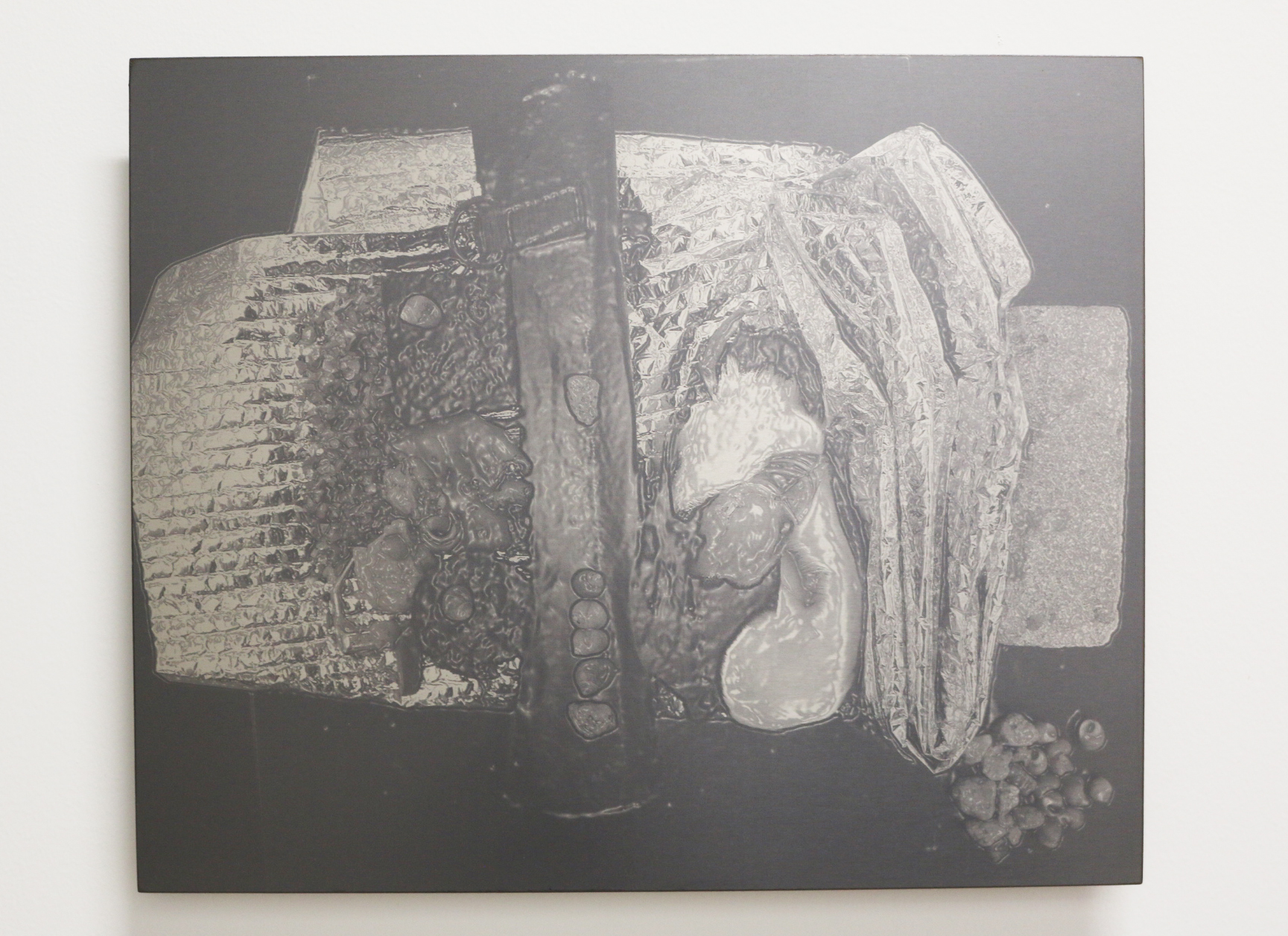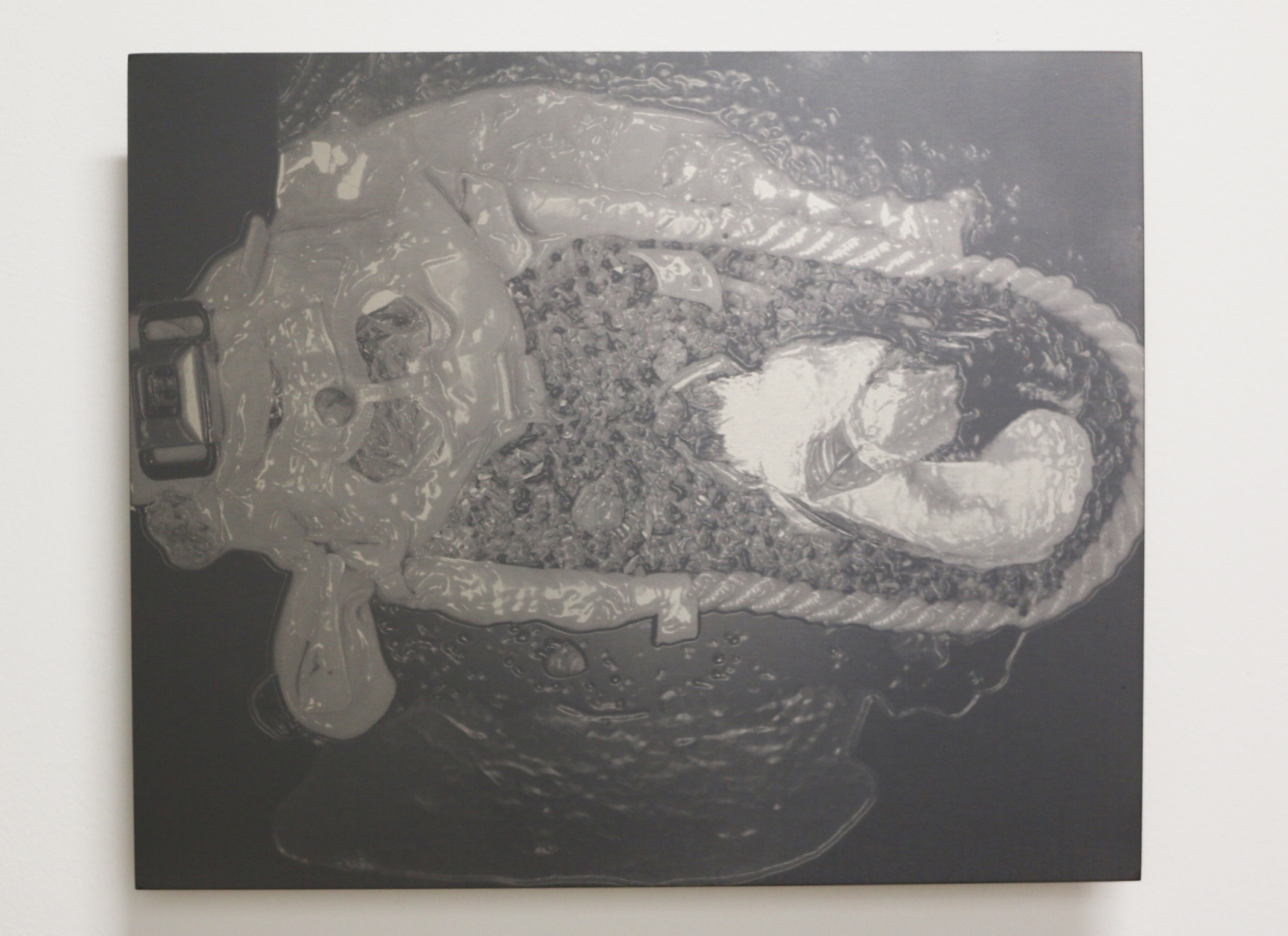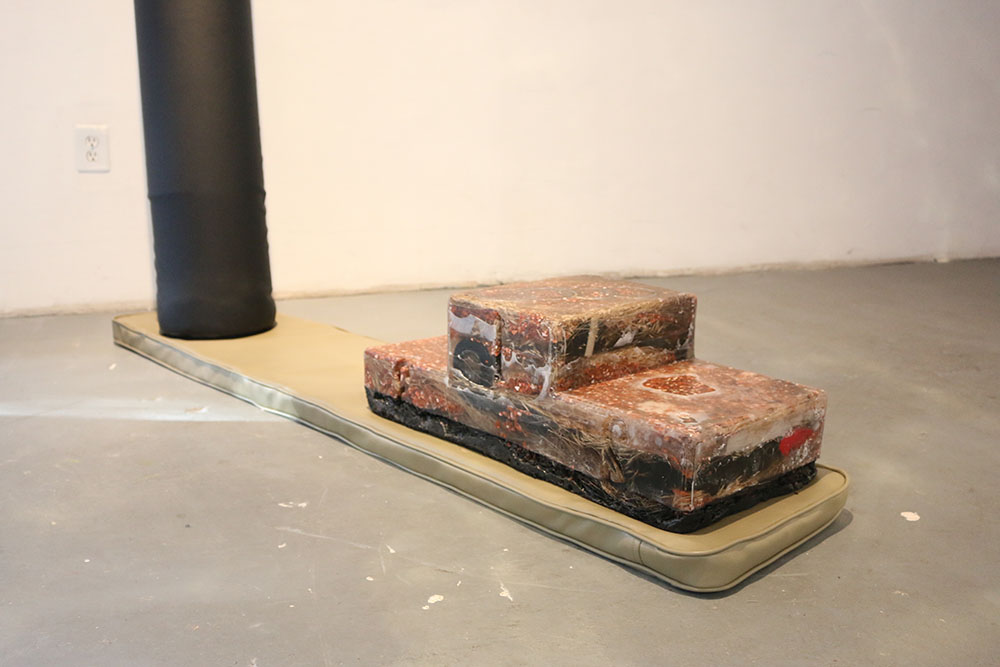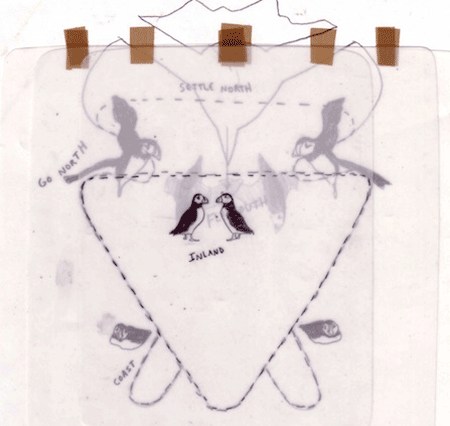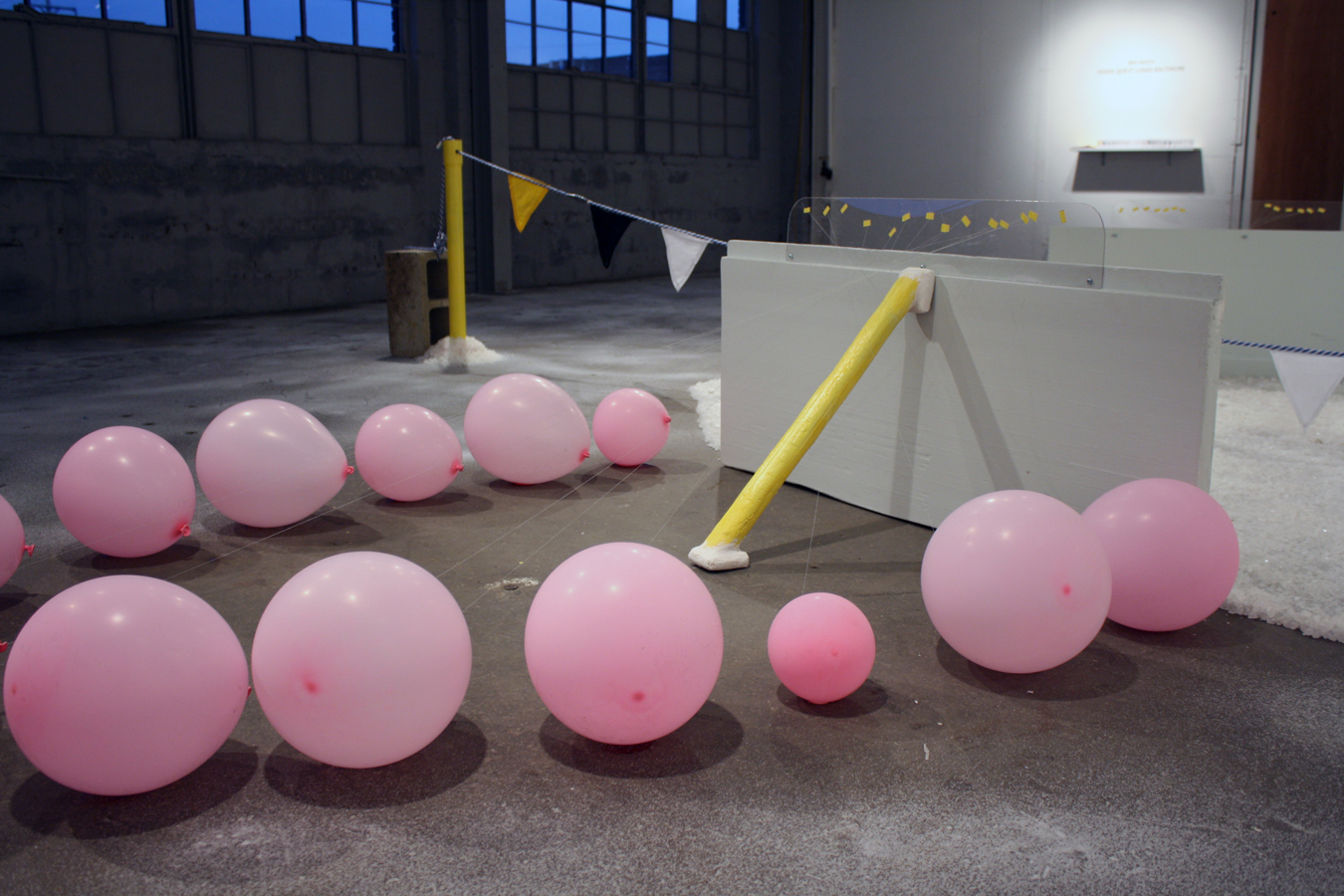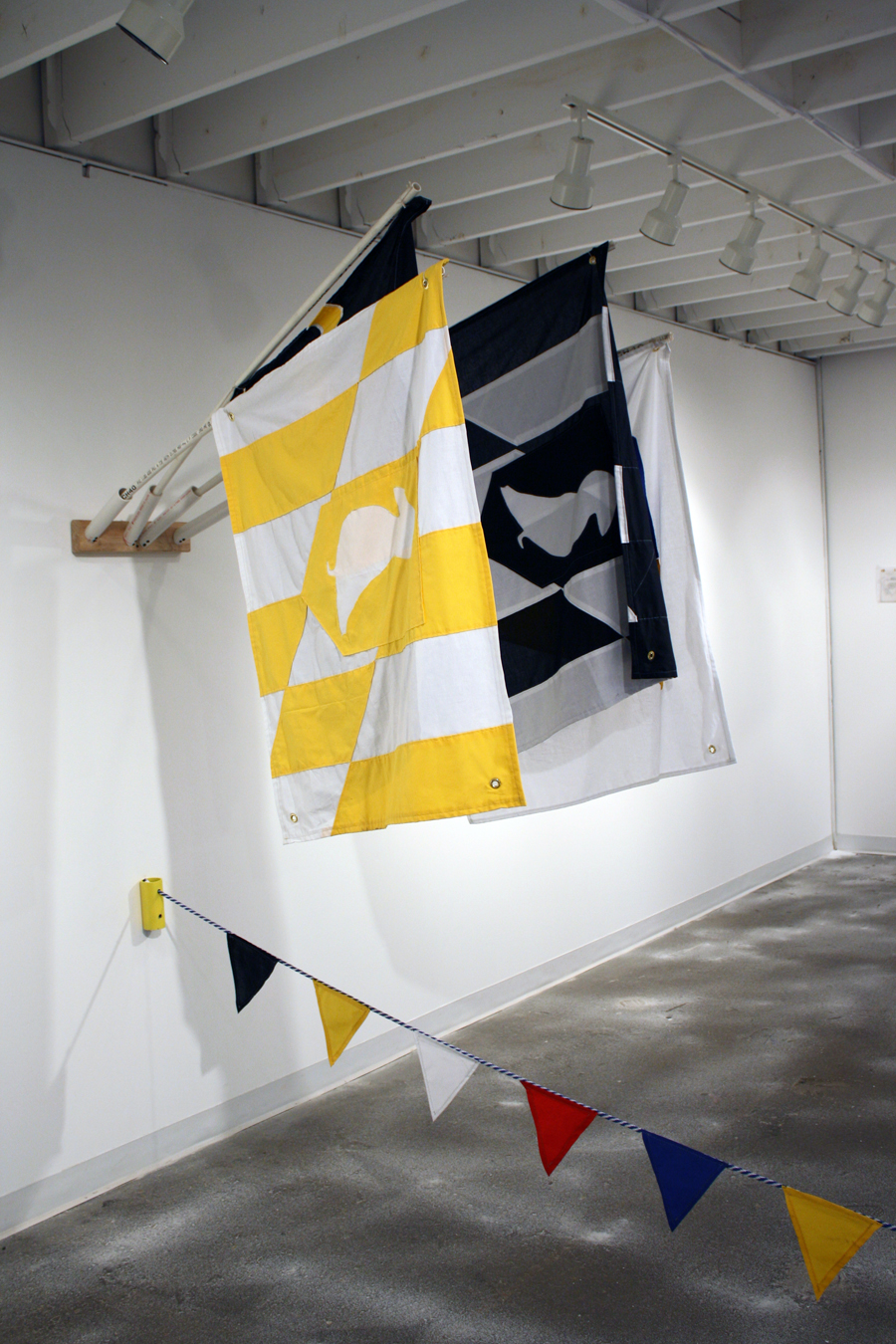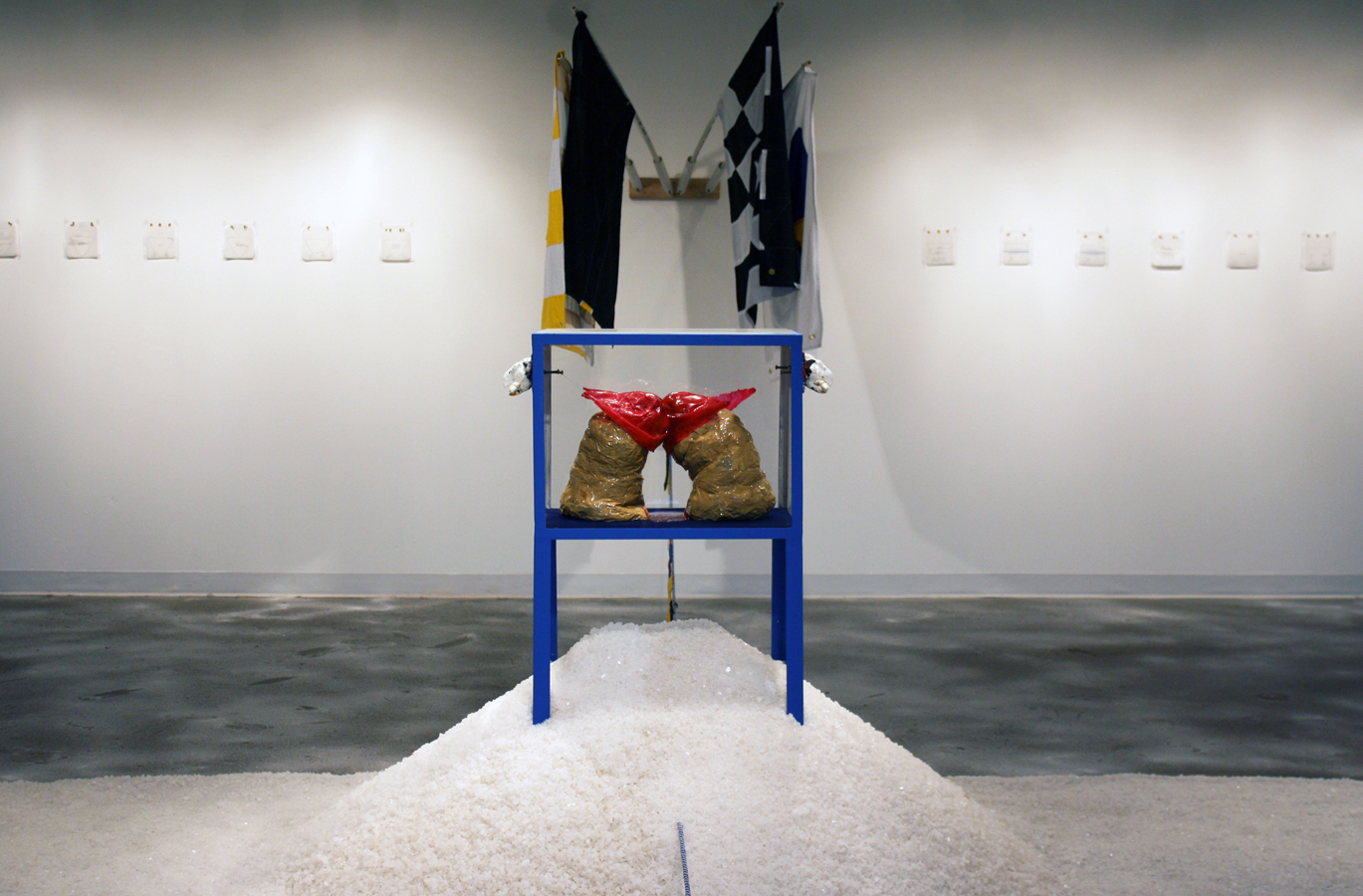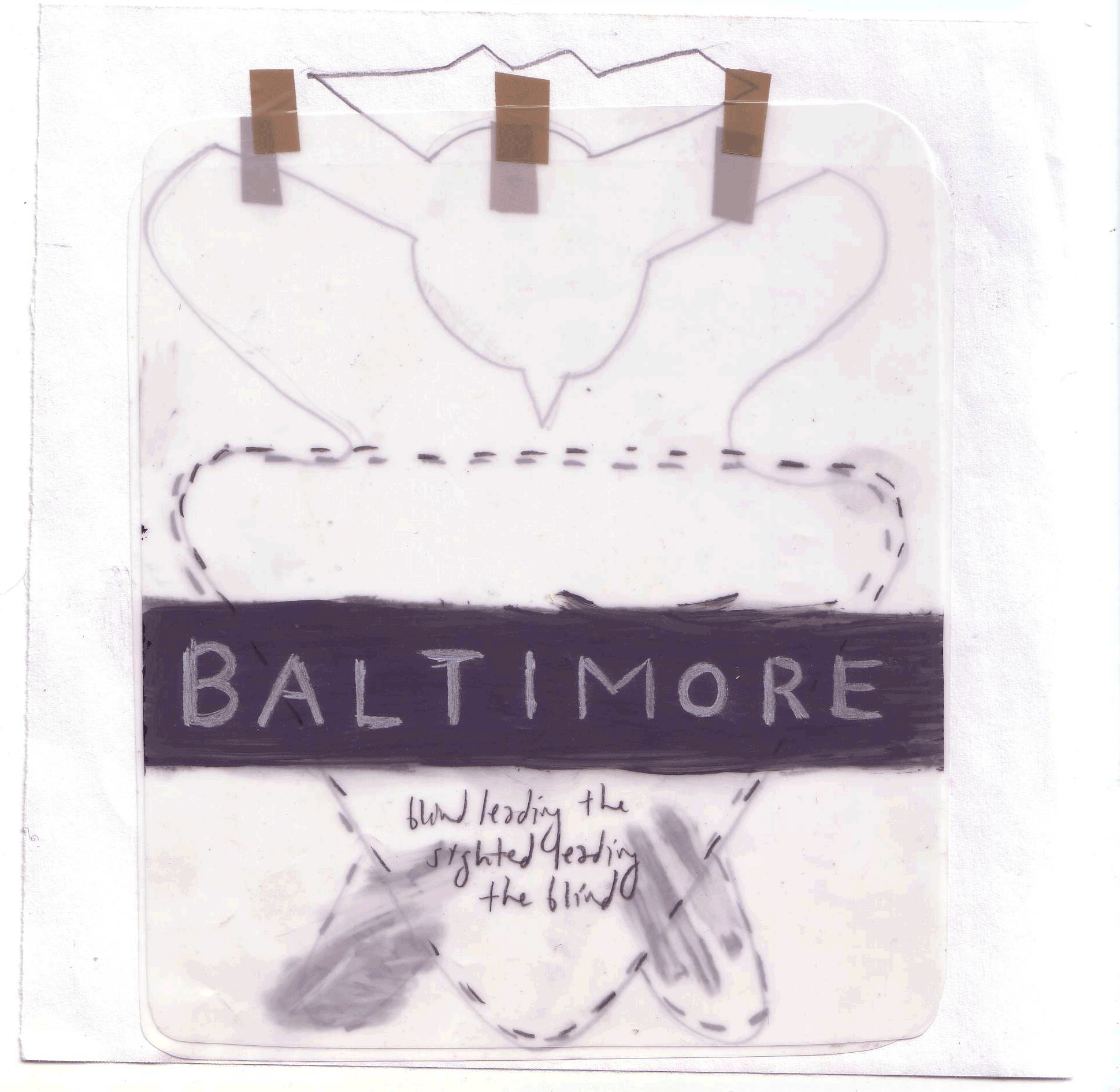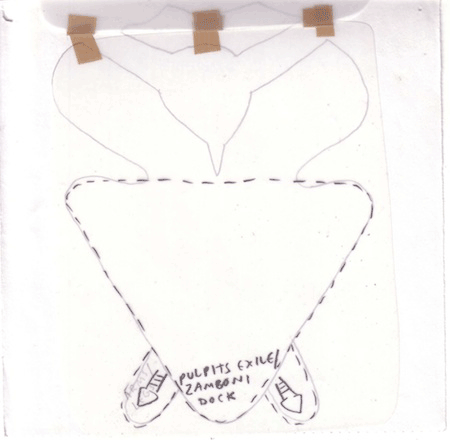About BEKÍ

Bekí Basch is an interdisciplinary artist who creates objects and experiential installations in the context of field research and ruminations on psychospirituality. Using a vocabulary associated with simulated environments and curated experiences (museums, aquariums, ice rinks, dioramas, artifacts), she draws together personally resonant and ostensibly disparate elements to express a new narrative of interconnectivity and possibility.
Her work has been exhibited in the US and… more
Vision Quest Lundi: Flush/Flood
Clay animation, burlap, cat litter, water, toilet, rubber, tape, iron, incense, inkjet prints on paper
Vision Quest Lundi: Flush/Flood is the second installment in the ongoing Vision Quest Lundi series, which is a wide-reaching narrative journey through marked stages of the ‘monomyth' (one true story) as detailed by the late Joseph Campbell. Vision Quest Lundi builds the framework for myth from facets of history, culture, religion and academics— accessing the spiritual qualities of disparately connected moments and placing them accordingly to function within a new system.
Vision Quest Lundi: Flush/Flood lies between two major points on a hypothetical map for the monomyth: the point where one looks outward for meaning (a person on some physical or mental precipice) and the following stage where one looks inward. These may present themselves metaphorically as a pier and a cave. Focusing on the high-intensity, circuitous movement in Formula 1 racing and the collective heart-pounding beat of Japanese drumming, this exhibition and performance express the possibility of physically progressing to the next stages by way of a meditative transcendence achieved through these activities. Rather than a clear and direct path, one exists between two spaces and finds balance which leads to transformation through repetition.
-
 FLOODMarker and paint on burlap. FLUSH and FLOOD are complementary. As a pier (which juts out into the water) is complementary from a cave (which can accept a flow of water into itself), our bodies breathe in and breathe out. We flood with air, and flush carbon dioxide. These complementary situations are the rhythms that underscore everything. This flag is the emblem for 'FLOOD'.
FLOODMarker and paint on burlap. FLUSH and FLOOD are complementary. As a pier (which juts out into the water) is complementary from a cave (which can accept a flow of water into itself), our bodies breathe in and breathe out. We flood with air, and flush carbon dioxide. These complementary situations are the rhythms that underscore everything. This flag is the emblem for 'FLOOD'. -
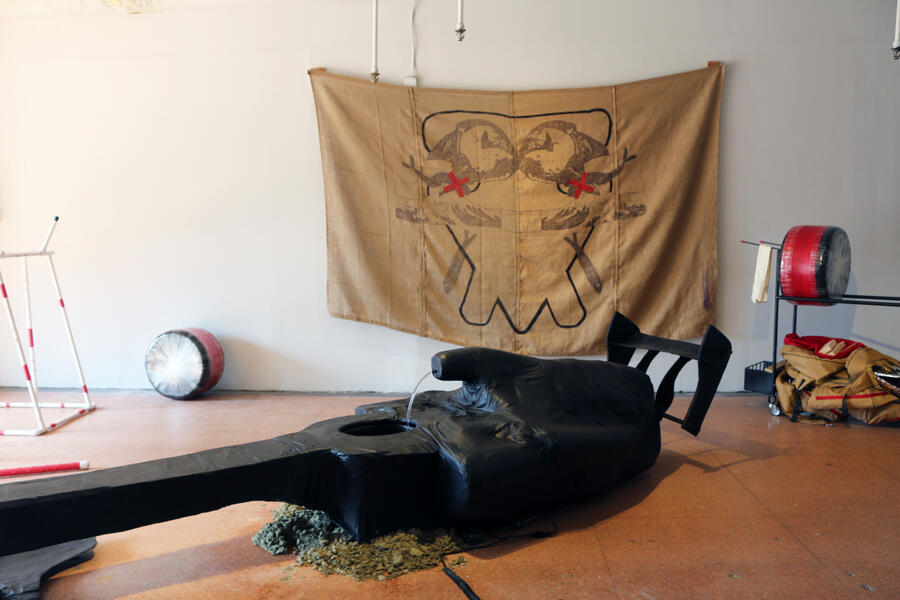 FLUSHMarker and paint on burlap. FLUSH and FLOOD are complementary. As a pier (which juts out into the water) is complementary from a cave (which can accept a flow of water into itself), our bodies breathe in and breathe out. We flood with air, and flush carbon dioxide. These complementary situations are the rhythms that underscore everything. This flag is the emblem for 'FLUSH'.
FLUSHMarker and paint on burlap. FLUSH and FLOOD are complementary. As a pier (which juts out into the water) is complementary from a cave (which can accept a flow of water into itself), our bodies breathe in and breathe out. We flood with air, and flush carbon dioxide. These complementary situations are the rhythms that underscore everything. This flag is the emblem for 'FLUSH'. -
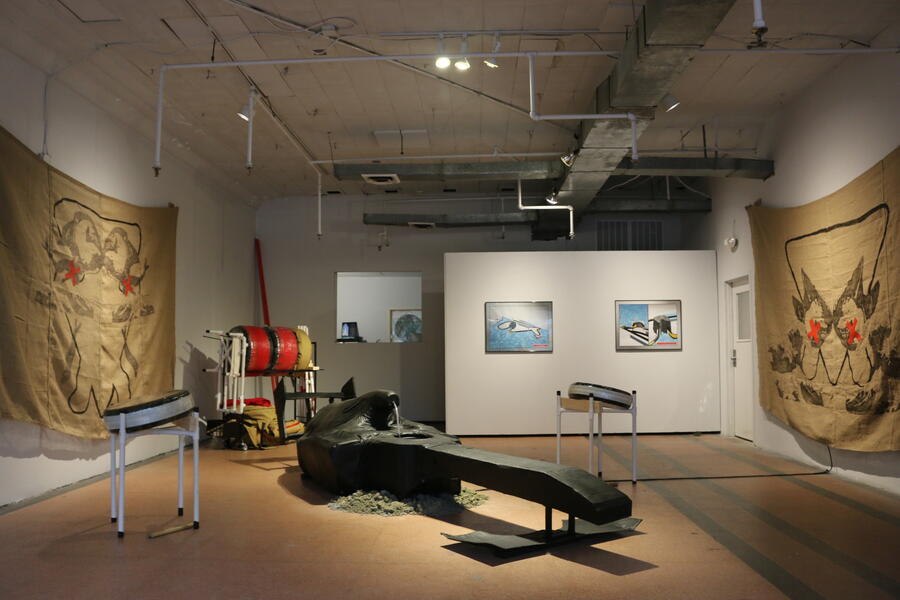 Automated Physiology = Situation for TranscendenceRubberized paint, foam, cardboard, cotton, wood, rubberized toilet, submersible pump, rubber mouth nozzle, vinyl tubing, cat litter. In the sport of F1, a driver is not alone in their decision-making. An entire support team of highly knowledgeable and specialized professionals guide the process, well beyond the mere construction of the vehicle. A driver is yet another member of the team who is in charge of the human element. They are physically fit, mentally adept and meet other important qualifications. Every circuit Formula races on is different from the next. A driver must practice and memorize the layout in order to find their most efficient path and vehicle handling. This memorization and the eventual repetitiveness of the race itself, becomes fused into muscle memory. Drivers have described this experience as meditative— sometimes even an out-of-body-experience when one's physical self is so in tune with their mind, that the connection allows one to break free from their earthly presence. Because the races are long and demanding, drivers hydrate via a tube connected to their helmet and a bladder within the cockpit. If, however, they need to relieve themselves, they are left to their own devices and will urinate without stopping. This to-scale model of the body of an F1 car is fitted with a toilet cockpit and a submersible pump, flooding and flushing water through an internal system continuously.
Automated Physiology = Situation for TranscendenceRubberized paint, foam, cardboard, cotton, wood, rubberized toilet, submersible pump, rubber mouth nozzle, vinyl tubing, cat litter. In the sport of F1, a driver is not alone in their decision-making. An entire support team of highly knowledgeable and specialized professionals guide the process, well beyond the mere construction of the vehicle. A driver is yet another member of the team who is in charge of the human element. They are physically fit, mentally adept and meet other important qualifications. Every circuit Formula races on is different from the next. A driver must practice and memorize the layout in order to find their most efficient path and vehicle handling. This memorization and the eventual repetitiveness of the race itself, becomes fused into muscle memory. Drivers have described this experience as meditative— sometimes even an out-of-body-experience when one's physical self is so in tune with their mind, that the connection allows one to break free from their earthly presence. Because the races are long and demanding, drivers hydrate via a tube connected to their helmet and a bladder within the cockpit. If, however, they need to relieve themselves, they are left to their own devices and will urinate without stopping. This to-scale model of the body of an F1 car is fitted with a toilet cockpit and a submersible pump, flooding and flushing water through an internal system continuously. -
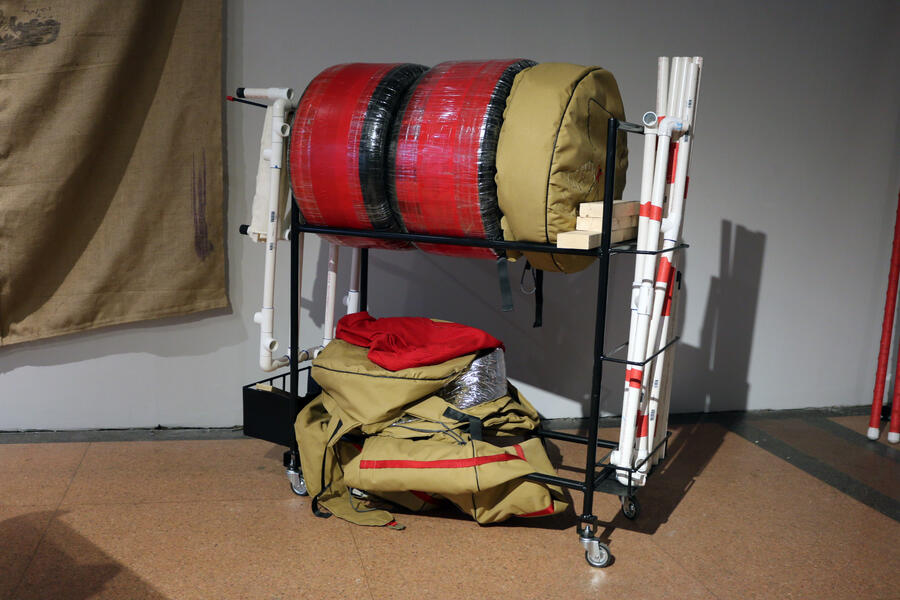 Tools for Communal TranscendencePolyester, embroidery, PVC, tires, masking tape, packing tape, duct tape, steel, plastic. Cost-effective taiko practice drums are often made from car tires with packing tape wrapped tightly around to make a thumping hollow space. Single tires make nagado daiko, a sandwich of four tires make an o daiko and a wood block acts as a shime daiko. Backpacks and sling bags resembling both musical instrument transport luggage and spare tire covers are fashioned from strong utility fabrics. The backpacks that hold the nagado daiko are lined with mylar padding, reminiscent of spare tire warmers used in Formula 1. During the exhibition, a local all-women drum group follows a score like a memorized narrative.
Tools for Communal TranscendencePolyester, embroidery, PVC, tires, masking tape, packing tape, duct tape, steel, plastic. Cost-effective taiko practice drums are often made from car tires with packing tape wrapped tightly around to make a thumping hollow space. Single tires make nagado daiko, a sandwich of four tires make an o daiko and a wood block acts as a shime daiko. Backpacks and sling bags resembling both musical instrument transport luggage and spare tire covers are fashioned from strong utility fabrics. The backpacks that hold the nagado daiko are lined with mylar padding, reminiscent of spare tire warmers used in Formula 1. During the exhibition, a local all-women drum group follows a score like a memorized narrative. -
 Yuru-chara incense holderCast iron on figurine mirror base. Inspired by Japanese mascots for products, campaigns and prefectures, this character is modeled after a Formula 1 racing tire and a Playmobil figurine, with the face of Sanrio's Rilakkuma. Its name is 'Taiya no tatsujin', which translates to 'tire master' and is borrowed from the Japanese claymation 'Taiko no tatsujin'— a claymation series about talking taiko drums. This iron cast was modeled first as a 3d print to precisely mimic those borrowed styles. Each hand has a hole in the palm, passing through into the arm so that the figure can hold two incense sticks at one time.
Yuru-chara incense holderCast iron on figurine mirror base. Inspired by Japanese mascots for products, campaigns and prefectures, this character is modeled after a Formula 1 racing tire and a Playmobil figurine, with the face of Sanrio's Rilakkuma. Its name is 'Taiya no tatsujin', which translates to 'tire master' and is borrowed from the Japanese claymation 'Taiko no tatsujin'— a claymation series about talking taiko drums. This iron cast was modeled first as a 3d print to precisely mimic those borrowed styles. Each hand has a hole in the palm, passing through into the arm so that the figure can hold two incense sticks at one time. -
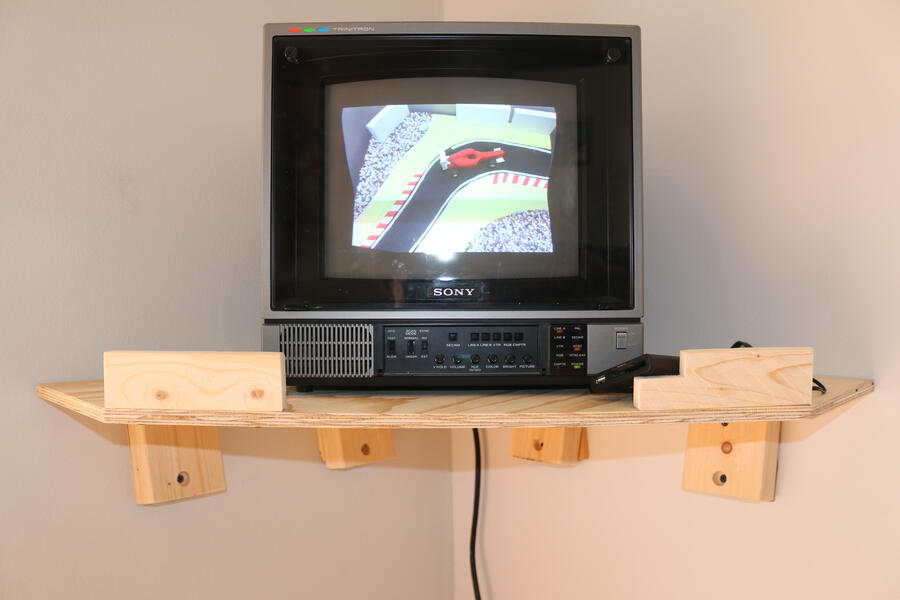 Transformation Through RepetitionClaymation on vintage SONY television. This claymation is the origin story of the Flush/Flood mascot Taiya no tatsujin. A racecar goes around and around the track repetitively and from this energy sprouts a little tire god from one of the front wheels. The arms of the god jut out, causing the car to veer off track and crash into a concrete wall. The tire rolls off and smiles contentedly. He is a little trickster. Borrowing from the Japanese claymation (based off a video game) 'Taiko no tatsujin' and Matthew Barney's Cremaster 4, this short lo-fi animation uses the universal concept of an 'origin story' to build value around a figure that ties into a larger myth. The kawaii cuteness of the character and the seemingly amoral logic of the story is an outsider interpretation of Japanese animation— a kind of fan fiction.
Transformation Through RepetitionClaymation on vintage SONY television. This claymation is the origin story of the Flush/Flood mascot Taiya no tatsujin. A racecar goes around and around the track repetitively and from this energy sprouts a little tire god from one of the front wheels. The arms of the god jut out, causing the car to veer off track and crash into a concrete wall. The tire rolls off and smiles contentedly. He is a little trickster. Borrowing from the Japanese claymation (based off a video game) 'Taiko no tatsujin' and Matthew Barney's Cremaster 4, this short lo-fi animation uses the universal concept of an 'origin story' to build value around a figure that ties into a larger myth. The kawaii cuteness of the character and the seemingly amoral logic of the story is an outsider interpretation of Japanese animation— a kind of fan fiction. -
 F/F Circuit PosterInkjet print on paper. This fantasy F1 circuit is based on a bisected version of a map of the monomyth. The place which is mapped— also a creation of fantasy— functions as a stage for the hero's quest. Here, the outline of the map is imagined as a racetrack, as the hero drives their racecar through each checkpoint in order to receive/achieve the progress points, like a video game.
F/F Circuit PosterInkjet print on paper. This fantasy F1 circuit is based on a bisected version of a map of the monomyth. The place which is mapped— also a creation of fantasy— functions as a stage for the hero's quest. Here, the outline of the map is imagined as a racetrack, as the hero drives their racecar through each checkpoint in order to receive/achieve the progress points, like a video game. -
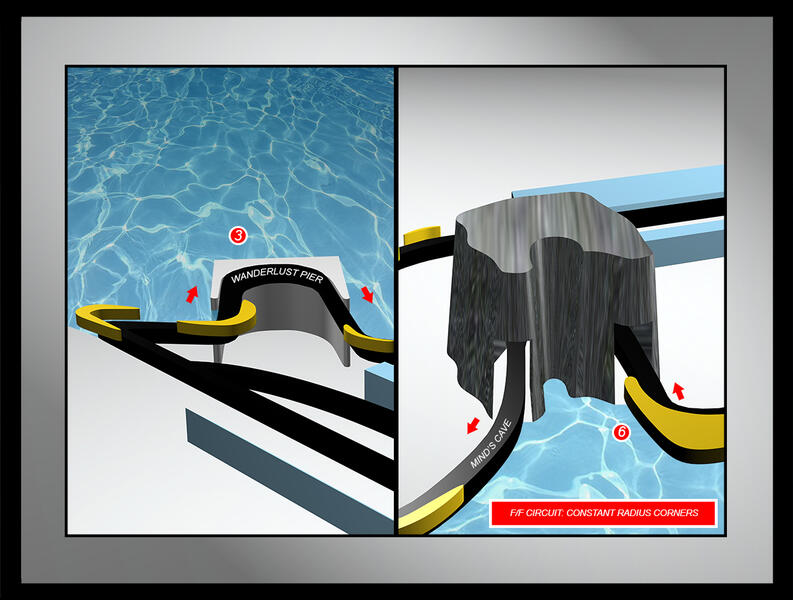 Constant Radius Corner PosterInkjet print on paper. Named after a type of curve in an F1 track, these two constant radius corners are magnified in a separate details poster to hi-light the two stops of the hero's path that FLUSH/FLOOD oscillates between. As the driver goes around and around the track continuously, they hug the curves that geographically represent a pier and a cave. Opposite in their exterior/interior nature— the pier is a place from which to look out at the sea to the great beyond, while the cave is a space of natural deprivation, where one can be left alone with their thoughts. The F/F Circuit puts a visual to the mental meditative space of the racecar driver.
Constant Radius Corner PosterInkjet print on paper. Named after a type of curve in an F1 track, these two constant radius corners are magnified in a separate details poster to hi-light the two stops of the hero's path that FLUSH/FLOOD oscillates between. As the driver goes around and around the track continuously, they hug the curves that geographically represent a pier and a cave. Opposite in their exterior/interior nature— the pier is a place from which to look out at the sea to the great beyond, while the cave is a space of natural deprivation, where one can be left alone with their thoughts. The F/F Circuit puts a visual to the mental meditative space of the racecar driver. -
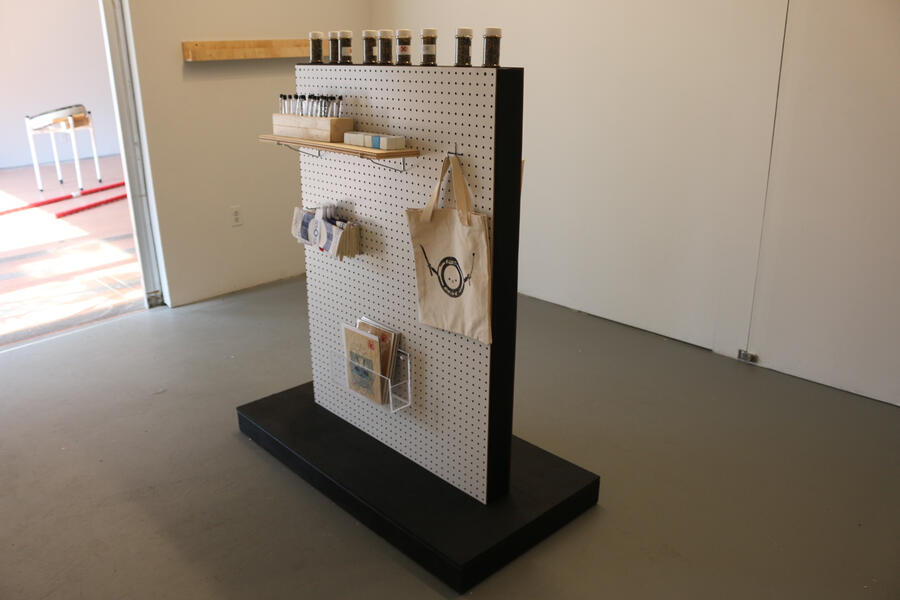 Souvenir ShopWood, pegboard, canvas, concrete, paper, plastic, balloons, drawings on tea-dyed paper The souvenir shop was an actual small shop functioning for the duration of this exhibition. The shop sold thoughtfully handmade paraphernalia related to the exhibition, including incense holders, stress relievers, rice sprinkles, float vials, tote bags and traditional Japanese tenugui.
Souvenir ShopWood, pegboard, canvas, concrete, paper, plastic, balloons, drawings on tea-dyed paper The souvenir shop was an actual small shop functioning for the duration of this exhibition. The shop sold thoughtfully handmade paraphernalia related to the exhibition, including incense holders, stress relievers, rice sprinkles, float vials, tote bags and traditional Japanese tenugui.
SENNA
-
 STATIONS OF THE CRASHSteel, plastic, shrink wrap, inkjet prints, Hello Kitty bandages, Bondo, concrete, rubber, car debris, nylon webbing. Sculptural manifestations alluding to car crashes, car culture, ritual and safety procedures.
STATIONS OF THE CRASHSteel, plastic, shrink wrap, inkjet prints, Hello Kitty bandages, Bondo, concrete, rubber, car debris, nylon webbing. Sculptural manifestations alluding to car crashes, car culture, ritual and safety procedures. -
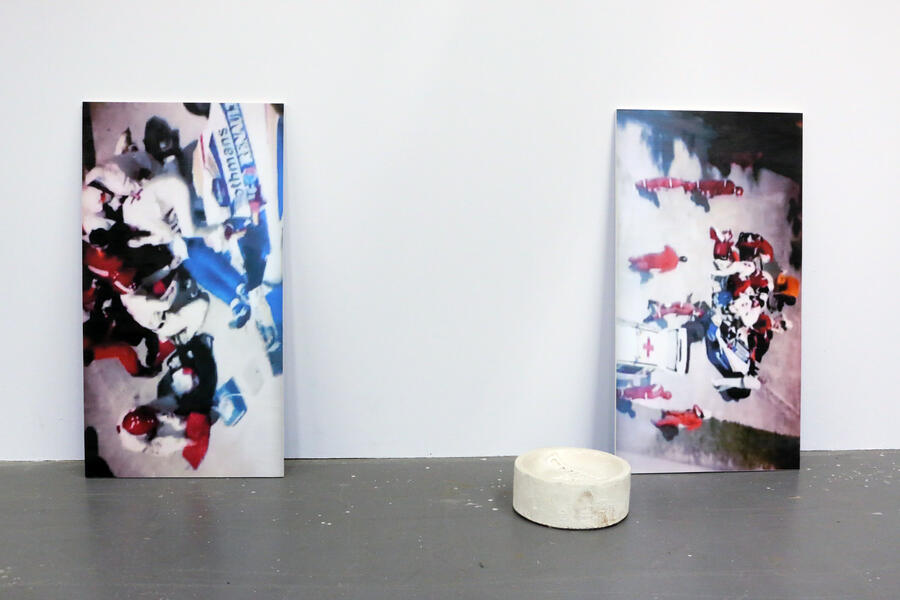 STATIONS OF THE CRASHInkjet prints, concrete, rubber. A couple of the panels from this installation. These are screenshots taken from the scene when Ayrton Senna was said to have passed. It is from a BBC documentary where a man claims to have felt Senna's spirit departing. In front of the right panel is a small concrete cylinder (resting on a thin slice of rubber), resembling a ritualistic water vessel, it is embossed with two logos perpendicular to one another, a shape close to that of a cross.
STATIONS OF THE CRASHInkjet prints, concrete, rubber. A couple of the panels from this installation. These are screenshots taken from the scene when Ayrton Senna was said to have passed. It is from a BBC documentary where a man claims to have felt Senna's spirit departing. In front of the right panel is a small concrete cylinder (resting on a thin slice of rubber), resembling a ritualistic water vessel, it is embossed with two logos perpendicular to one another, a shape close to that of a cross. -
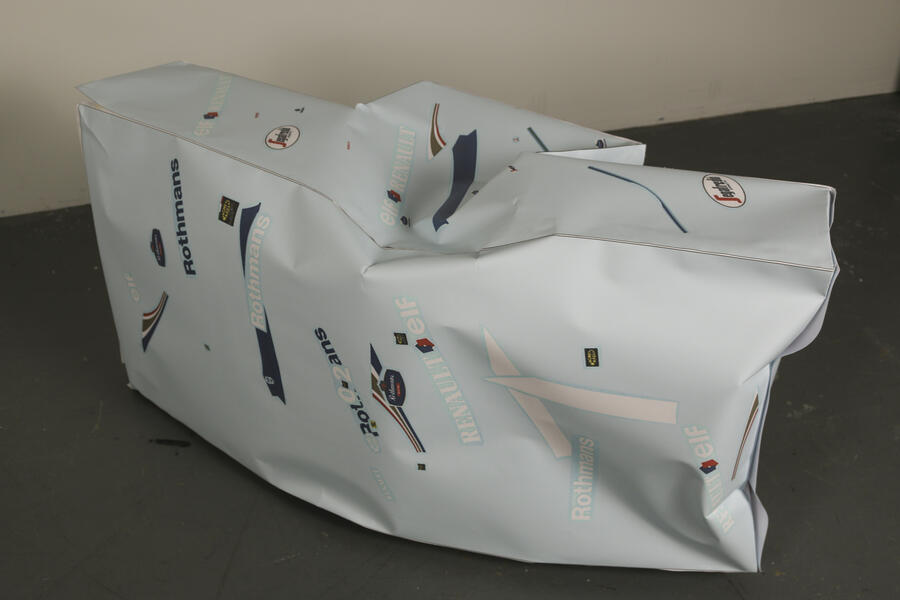 CONSTRUCTORS' CHAMPIONSHIPInkjet print on paper. A smooth matte inkjet print constructed into a life-size papercraft winner's podium. The large scale and lack of support makes the fragile object cave under its own weight, creating dents and folds that resemble a car body. Every logo from the car in which Ayrton Senna was killed, is strewn about at random onto the surface- as if someone made a model car kit and added every sticker, but with no care for placement. The Constructors' Championship is an overall team award given in Formula 1 racing for superior vehicle construction.
CONSTRUCTORS' CHAMPIONSHIPInkjet print on paper. A smooth matte inkjet print constructed into a life-size papercraft winner's podium. The large scale and lack of support makes the fragile object cave under its own weight, creating dents and folds that resemble a car body. Every logo from the car in which Ayrton Senna was killed, is strewn about at random onto the surface- as if someone made a model car kit and added every sticker, but with no care for placement. The Constructors' Championship is an overall team award given in Formula 1 racing for superior vehicle construction. -
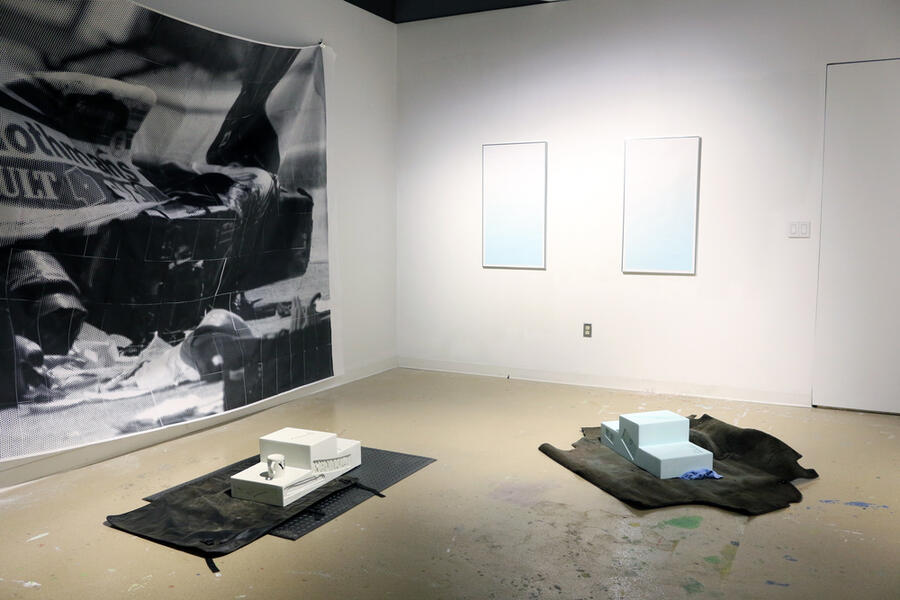 LIMINAL VALUEPigmented concrete, car mats, inkjet prints on paper. This installation focuses on the space between life and death as represented by works that represent a materially liminal space.
LIMINAL VALUEPigmented concrete, car mats, inkjet prints on paper. This installation focuses on the space between life and death as represented by works that represent a materially liminal space. -
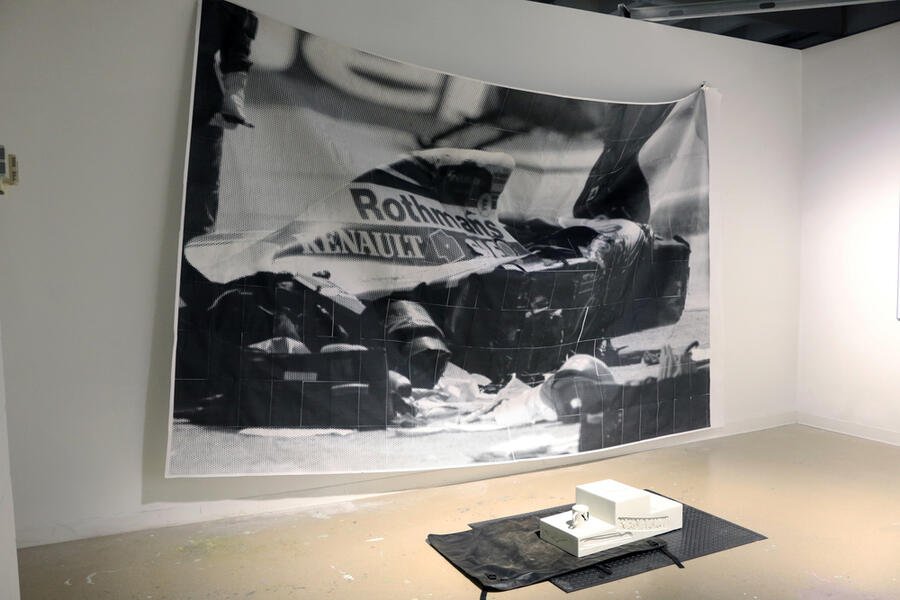 LIMINAL VALUEPigmented concrete, car mats, inkjet prints on paper. Heavy concrete podiums are lightened with pigments and scaled down to a non-functional size, with embossed logos from Senna's car that relate them to gravestones. Their shape and placement on car mats also likens them to very crude car shapes. Hanging behind this podium is a pixelated screenshot from Senna's crash, pieced together with hundreds of sheets of paper and hung like a piece of fabric.
LIMINAL VALUEPigmented concrete, car mats, inkjet prints on paper. Heavy concrete podiums are lightened with pigments and scaled down to a non-functional size, with embossed logos from Senna's car that relate them to gravestones. Their shape and placement on car mats also likens them to very crude car shapes. Hanging behind this podium is a pixelated screenshot from Senna's crash, pieced together with hundreds of sheets of paper and hung like a piece of fabric. -
 REMAINSDebossing on card stock in blue shadowbox frames 12"x12" From a series of 4, card stock is debossed with a logo synonymous with Ayrton Senna and F1 racing. As a celebrity can don a hat and give it iconic status we then associate with them— F1 vehicles are recognized by their unique designs made up of branding. Their placement in relation to certain features on a car shares a logic with tattoo placement.
REMAINSDebossing on card stock in blue shadowbox frames 12"x12" From a series of 4, card stock is debossed with a logo synonymous with Ayrton Senna and F1 racing. As a celebrity can don a hat and give it iconic status we then associate with them— F1 vehicles are recognized by their unique designs made up of branding. Their placement in relation to certain features on a car shares a logic with tattoo placement. -
 CÈU AZUL / MAR AZUL22" x 40" each Two inkjet prints of light blue gradients with debossing. On one is an arrangement of logos placed loosely where they would be on Senna's vehicle, and the other is a sweeping array of the same logos as if they were blown off the paper. The gradients are also in slightly different directions. Each piece is framed by a common poster frame, enhancing the reflective aluminum in contrast to the clean, matte, almost non-existent image content.
CÈU AZUL / MAR AZUL22" x 40" each Two inkjet prints of light blue gradients with debossing. On one is an arrangement of logos placed loosely where they would be on Senna's vehicle, and the other is a sweeping array of the same logos as if they were blown off the paper. The gradients are also in slightly different directions. Each piece is framed by a common poster frame, enhancing the reflective aluminum in contrast to the clean, matte, almost non-existent image content. -
 CEU AZUL / MAR AZULAthletes are often identified by their player numbers. Of the few logos selected to represent Senna's vehicle, '02' is at the tip. In an F1 team there are two drivers and their car are nearly identical, save for this number,
CEU AZUL / MAR AZULAthletes are often identified by their player numbers. Of the few logos selected to represent Senna's vehicle, '02' is at the tip. In an F1 team there are two drivers and their car are nearly identical, save for this number, -
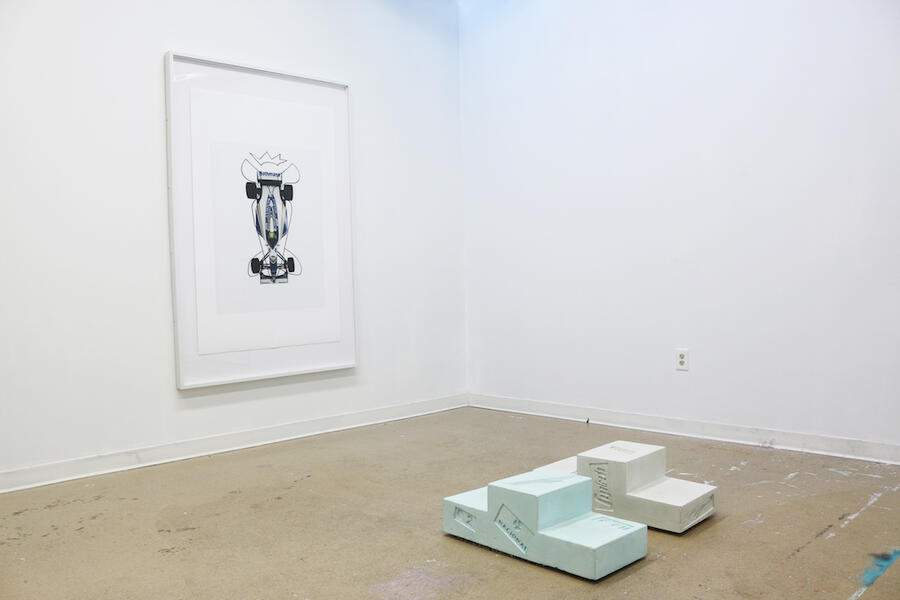 Williams Renault FW16 ESPIRITO / A BIT OF DEBRISInkjet print on paper, pigmented concrete. An image of Senna's last vehicle, printed on paper, then scanned back into the computer, then crumpled, run over by a truck, scanned back in and printed. This installation is accompanied by the two twin concrete podiums, reflecting both the dualities in life and the duality of life and death.
Williams Renault FW16 ESPIRITO / A BIT OF DEBRISInkjet print on paper, pigmented concrete. An image of Senna's last vehicle, printed on paper, then scanned back into the computer, then crumpled, run over by a truck, scanned back in and printed. This installation is accompanied by the two twin concrete podiums, reflecting both the dualities in life and the duality of life and death. -
 Williams Renault FW16 ESPIRITO / A BIT OF DEBRIS
Williams Renault FW16 ESPIRITO / A BIT OF DEBRIS
REAPER
Inkjet prints on stainless steel
14" x 17"
The series REAPER represents an array of objects (including a dead puffin, car parts, organic matter, packing material and leather) arranged on a flat surface and photographed from above. The items selected for each composition represent contrasting qualities of physical texture and cultural value, which are pushed into the abstract realm as the photographic process blurs their defined boundaries and flattens their tactility. Ideas of value shift as the cheap poses for luxury and the natural becomes grotesque.
COLORADO
-
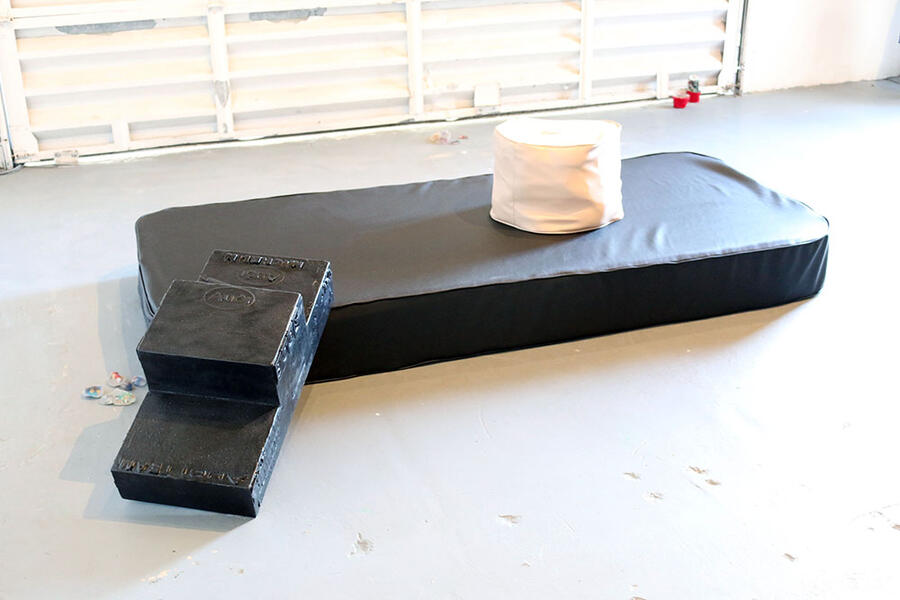 COLORADORubberized wood, leatherette, resin, debris, foam
COLORADORubberized wood, leatherette, resin, debris, foam -
 COLORADORubberized wood, leatherette, resin, debris, foam
COLORADORubberized wood, leatherette, resin, debris, foam -
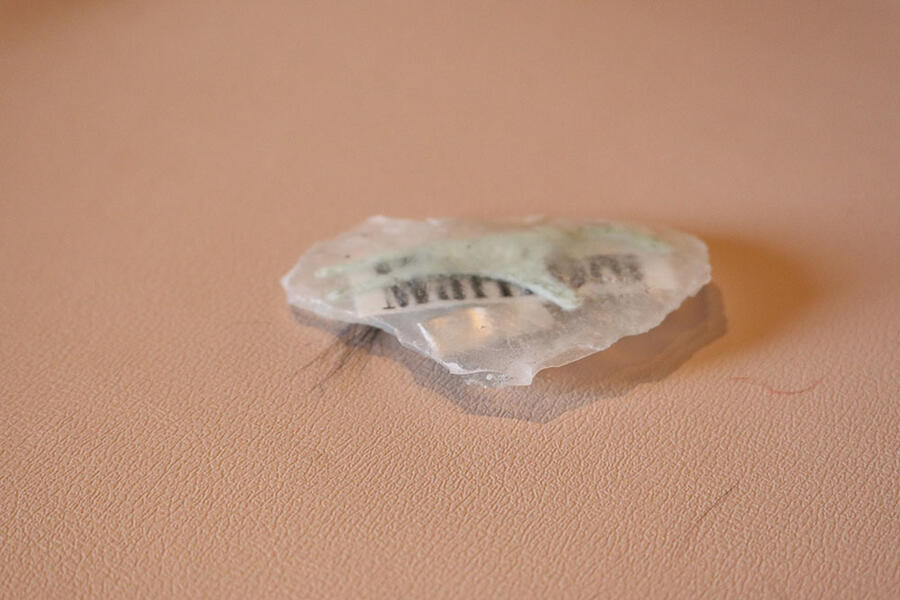 COLORADOLeatherette, resin, debris, foam, cat hair
COLORADOLeatherette, resin, debris, foam, cat hair -
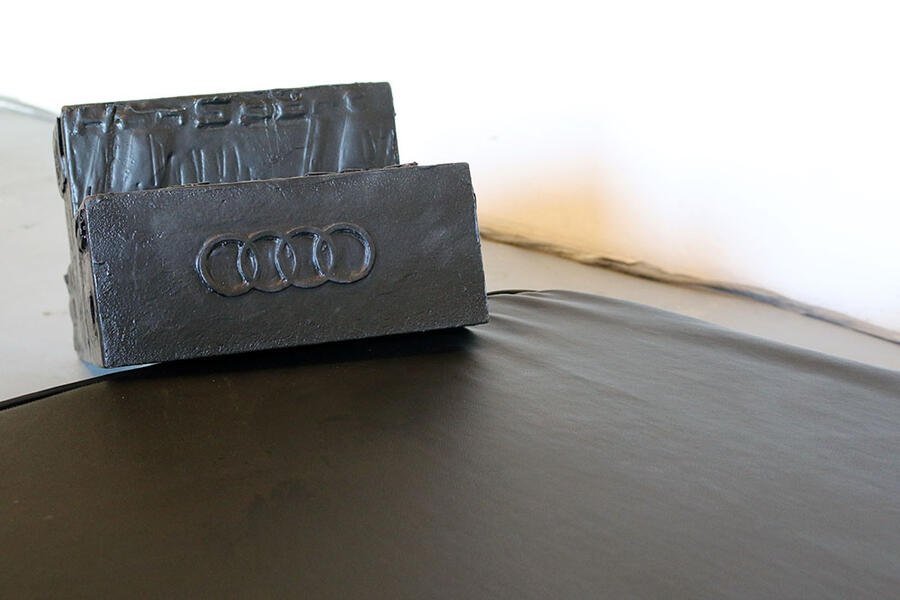 COLORADORubberized wood, leatherette, foam
COLORADORubberized wood, leatherette, foam -
 COLORADOLeatherette, resin, debris, foam, plastic, grass, car pieces
COLORADOLeatherette, resin, debris, foam, plastic, grass, car pieces -
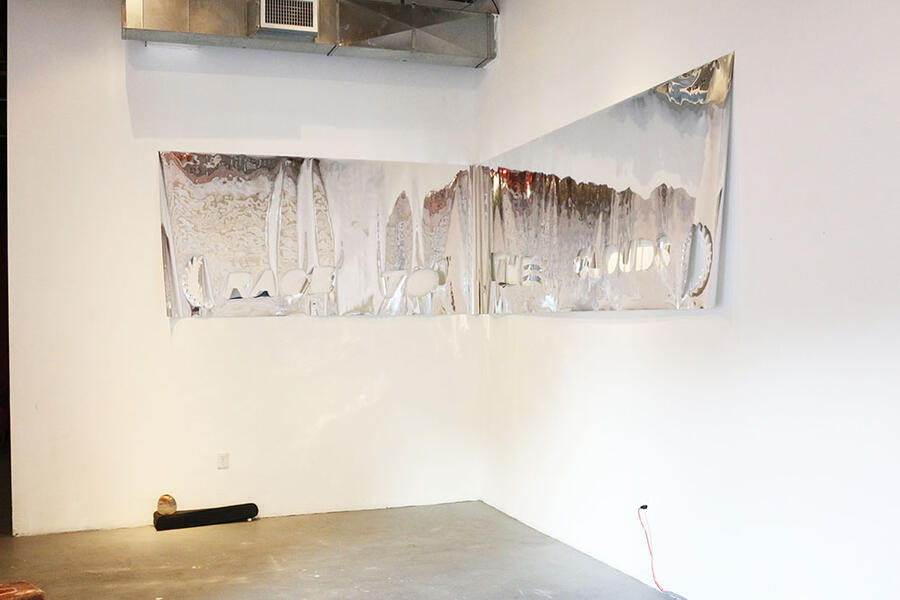 COLORADOLeatherette, foam, resin, debris, mylar
COLORADOLeatherette, foam, resin, debris, mylar -
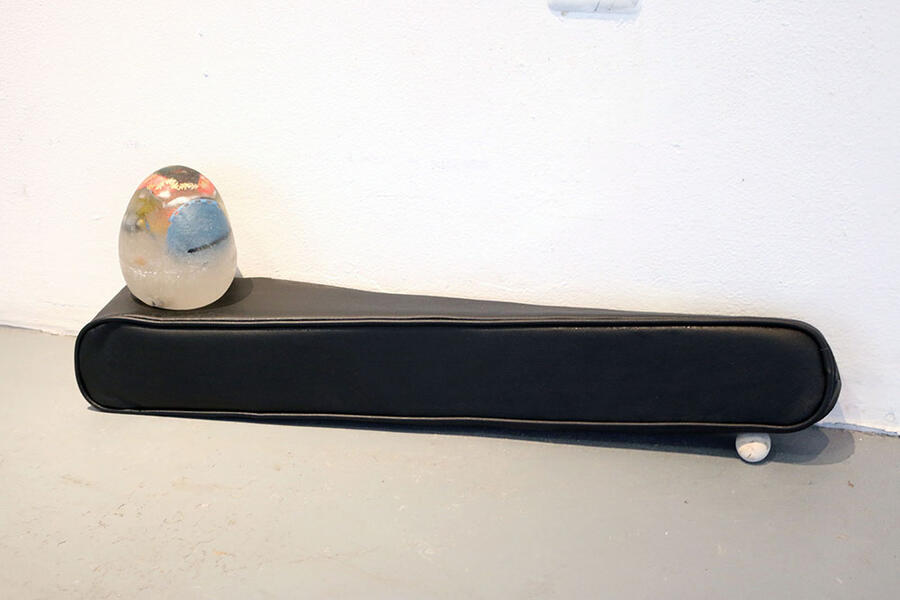 COLORADOLeatherette, foam, resin, debris
COLORADOLeatherette, foam, resin, debris
Vision Quest Lundi: Baltimore
Vision Quest Lundi: Baltimore is a film, an exhibition, and a book that stem from the same narrative. Two characters participate in a ritual that is reminiscent of marriage, but draws imagery and action from diverse cultures which customizes the conditions of their communion. Religion, athletics, biography, art history and local Baltimore artists, are borrowed for their existing logic to assist in actions of joining and separating.
This project is the first in a series of works that travel the path of the ‘monomyth’, as detailed by Joseph Campbell.
-
Vision Quest Lundi: BaltimoreA Baltimore love story. Beginning with a bicycle processional, two lovers are set on a pre-determined course. Puffins swim under ice as the lovers are put through a ritual of pulling church-like pulpits across an ice rink as camo-wearing onlookers eagerly await. The master of ceremony steps in and joins the lovers and just as soon, the audience storms the ice and breaks it apart. The lovers are zipped up in body bags and sent to sea by way of the Inner Harbor.
-
Vision Quest Lundi: Baltimore
-
Vision Quest Lundi: Baltimore
-
 Burial Mound at the Mimi DiPietro Ice RinkVision Quest Lundi: Baltimore exhibition at the Open Space Gallery in Baltimore, MD. The first room is the installation Burial Mound at the Mimi DiPietro Ice Rink and the second room is a screening of the Vision Quest film. Materials drawn from the film create a sculptural interpretation that extends the spatial, spiritual, and psychological implications of the narrative.
Burial Mound at the Mimi DiPietro Ice RinkVision Quest Lundi: Baltimore exhibition at the Open Space Gallery in Baltimore, MD. The first room is the installation Burial Mound at the Mimi DiPietro Ice Rink and the second room is a screening of the Vision Quest film. Materials drawn from the film create a sculptural interpretation that extends the spatial, spiritual, and psychological implications of the narrative. -
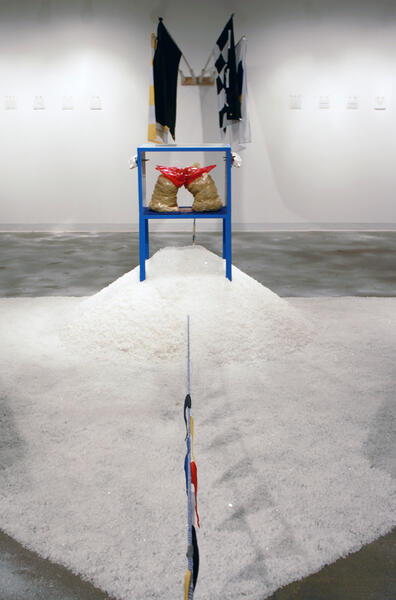 Burial Mound at the Mimi DiPietro Ice Rink
Burial Mound at the Mimi DiPietro Ice Rink -
 Burial Mound at the Mimi DiPietro Ice Rink
Burial Mound at the Mimi DiPietro Ice Rink -
 Model DiagramsDiagrams drawn on layers of vellum illustrate situations imposed onto a consistent shape. The shape is broken down intoconsecutive layers as stages of a situation.
Model DiagramsDiagrams drawn on layers of vellum illustrate situations imposed onto a consistent shape. The shape is broken down intoconsecutive layers as stages of a situation. -
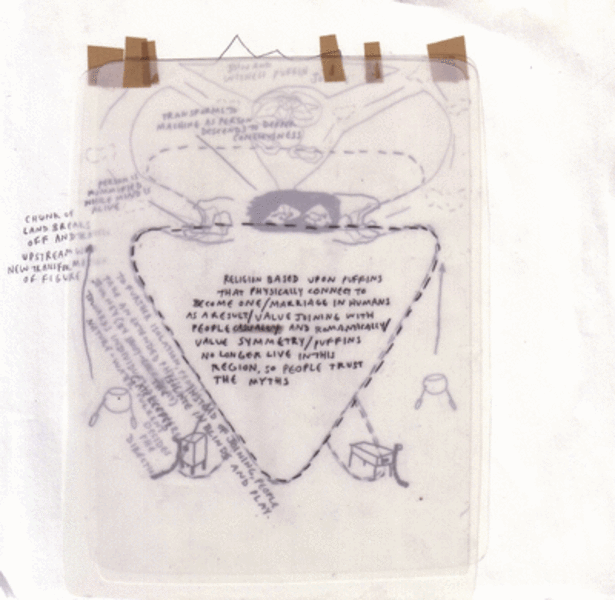 Model Diagrams
Model Diagrams
BURIAL MOUND AT THE MIMI DIPIETRO ICE RINK
This installation is a sculptural representation of the video VISION QUEST LUNDI: BALTIMORE. The footprint of the room-sized sculpture mimics both an ice rink and the diagrams hung on the walls around it. Materials used in both the video and the installation provide visual continuity and the addition of rock salt where otherwise there would be ice, suggests a moment of change. Salt would theoretically melt the ice and so the rink is a futile setting.
-
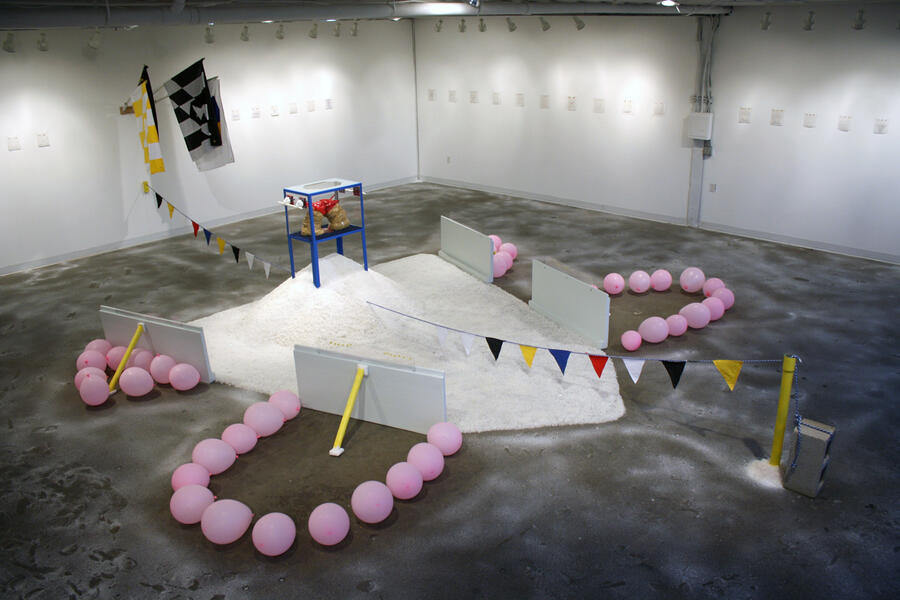 BURIAL MOUND AT THE MIMI DIPIETRO ICE RINK
BURIAL MOUND AT THE MIMI DIPIETRO ICE RINK -
 BURIAL MOUND AT THE MIMI DIPIETRO ICE RINK
BURIAL MOUND AT THE MIMI DIPIETRO ICE RINK -
 BURIAL MOUND AT THE MIMI DIPIETRO ICE RINK
BURIAL MOUND AT THE MIMI DIPIETRO ICE RINK -
 BURIAL MOUND AT THE MIMI DIPIETRO ICE RINK
BURIAL MOUND AT THE MIMI DIPIETRO ICE RINK -
 BURIAL MOUND AT THE MIMI DIPIETRO ICE RINK
BURIAL MOUND AT THE MIMI DIPIETRO ICE RINK -
 MODEL DIAGRAMInk and pencil on vellum and paper. 6.5" X 6.5"
MODEL DIAGRAMInk and pencil on vellum and paper. 6.5" X 6.5" -
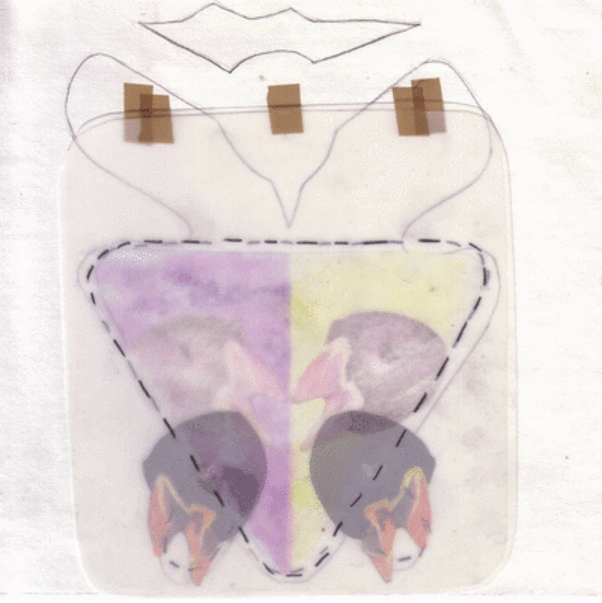 MODEL DIAGRAMInk on vellum and paper. 6.5" X 6.5"
MODEL DIAGRAMInk on vellum and paper. 6.5" X 6.5" -
 MODEL DIAGRAMInk and pencil on vellum and paper. 6.5" X 6.5"
MODEL DIAGRAMInk and pencil on vellum and paper. 6.5" X 6.5" -
 MODEL DIAGRAMInk and pencil on vellum and paper. 6.5" X 6.5"
MODEL DIAGRAMInk and pencil on vellum and paper. 6.5" X 6.5" -
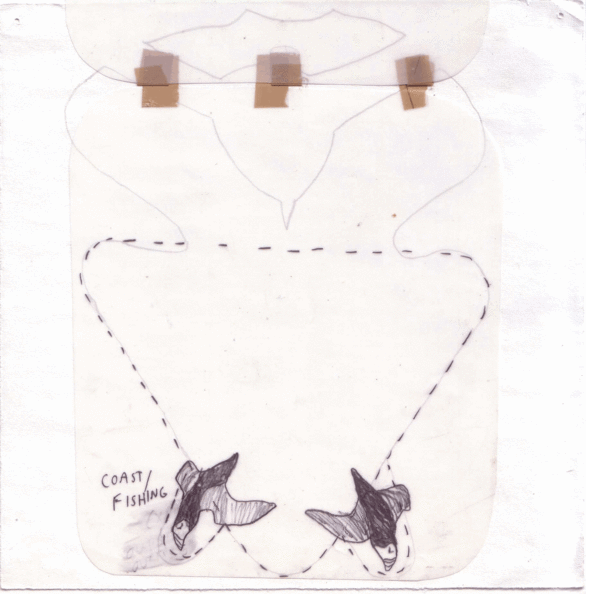 MODEL DIAGRAMInk and pencil on vellum and paper. 6.5" X 6.5"
MODEL DIAGRAMInk and pencil on vellum and paper. 6.5" X 6.5"
